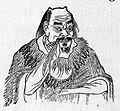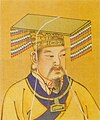Three Sovereigns and Five Emperors
| Three Sovereigns and Five Emperors | |||||||||||||
|---|---|---|---|---|---|---|---|---|---|---|---|---|---|
| Chinese | 三皇五帝 | ||||||||||||
| |||||||||||||
| Part of a series on the |
| History of China |
|---|
The Three Sovereigns and Five Emperors (Chinese: 三皇五帝; pinyin: Sānhuáng wǔdì; Wade–Giles: San-huang wu-ti) were a group of mythological rulers and deities from ancient China during the period circa 2852 BC to 2070 BC and seen as culture heroes[1]. This period preceded the Xia Dynasty.[2]
In myth, the Three Sovereigns were demigods who used their abilities to help create mankind and impart essential skills and knowledge. The Five Emperors were exemplary sages possessed of great moral character.
Variations
Depending on the source, there are many variations of who classifies as the Three Sovereigns or the Five Emperors. There are six to seven known variations.[3] Many of the sources listed below were written from much later dynasties.
The following appear in different groupings of the Three Sovereigns: Fuxi (伏羲), Nüwa (女媧), Shennong (神農), Suiren (燧人), Zhurong (祝融), Gong Gong (共工), Heavenly Sovereign (天皇), Earthly Sovereign (地皇), Tai Sovereign (泰皇), Human Sovereign (人皇), and even the Yellow Emperor (黄帝).
The following appear in different groupings of the Five Emperors: Yellow Emperor (黃帝), Zhuanxu (顓頊), Emperor Ku (嚳), Emperor Yao (堯), Shun (舜), Shaohao (少昊), Taihao (太昊), and Yan Emperor (炎帝).
Three Sovereigns
The Three Sovereigns, sometimes known as the Three August Ones, were said to be god-kings or demigods who used their magical powers to improve the lives of their people. Because of their lofty virtue, they lived to a great age and ruled over a period of great peace. The Three Sovereigns are ascribed various identities in different Chinese historical texts. The Yellow Emperor is supposedly the ancestor of the Huaxia people.[4] The Mausoleum of the Yellow Emperor was established in Shaanxi Province to commemorate the ancestry legend.[4]
| According to source | Three Sovereigns |
|---|---|
| Records of the Grand Historian (史記), addition by Sima Zhen | Heavenly Sovereign (天皇), Earthly Sovereign (地皇), Tai Sovereign (泰皇)[3] or Fu Xi (伏羲), Nüwa (女媧), Shennong (神農) |
| Sovereign series (帝王世系) | Fu Xi (伏羲), Shennong (神農), Yellow Emperor (黃帝)[3] |
| The book of Lineages (世本) | Fu Xi (伏羲), Shennong (神農), Yellow Emperor (黃帝)[3] |
| Baihu Tongyi (白虎通義) | (1st variation) Fu Xi (伏羲), Shennong (神農), Zhurong (祝融)[3] (2nd variation) Fu Xi (伏羲), Shennong (神農), Suiren (燧人)[3] |
| Fengsu TongYi (風俗通義) | Fu Xi (伏羲), Nüwa (女媧), Shennong (神農)[3] |
| Yiwen Leiju (藝文類聚) | Heavenly Sovereign (天皇), Earthly Sovereign (地皇); Human Sovereign (人皇)[3] |
| Tongjian Waiji (通鑑外紀) | Fu Xi (伏羲), Shennong (神農), Gong Gong (共工) |
| Chunqiu yundou shu (春秋運斗樞) Chunqiu yuanming bao (春秋元命苞) |
Fu Xi (伏羲), Nüwa (女媧), Shennong (神農) |
| Shangshu dazhuan (尚書大傳) | Fu Xi (伏羲), Shennong (神農), Suiren (燧人) |
| Diwang shiji (帝王世紀) | Fu Xi (伏羲), Shennong (神農), Yellow Emperor (黃帝) |
Five Emperors
| According to source | Five Emperors |
|---|---|
| Records of the Grand Historian (史記) | Yellow Emperor (黃帝), Zhuanxu (顓頊), Emperor Ku (嚳), Emperor Yao (堯), Shun (舜)[3] |
| Sovereign Series (帝王世紀) | Shaohao (少昊), Zhuanxu (顓頊), Emperor Ku (嚳), Emperor Yao (堯), Shun (舜)[3] |
| I Ching (易經) | Taihao (太昊), Yan Emperor (炎帝), Yellow Emperor (黃帝), Emperor Yao (堯), Shun (舜)[3] |
Creation myth
Chinese creation myths generally include Pangu. It is said that after his death his left eye became the sun, while the right eye became the moon. Different parts of his body became the world.[5] There is also the legend of the Four shi (四氏) who took part in creating the world. The four members are Youchao-shi (有巢氏), Suiren-shi (燧人氏), Fu Xi-shi (伏羲氏), and Shennong-shi (神農氏).[5]
Legacy
These kings are said to have helped introduce the use of fire, taught people how to build houses and invented farming. The Yellow Emperor's wife is credited with the invention of silk culture. The discovery of medicine, the invention of the calendar and Chinese script are also credited to the kings. After their era, Yu the Great founded the Xia Dynasty.[2]
Gallery
-
Shennong tasting herbs to discover their qualities
-
Historian's depiction of the Yellow Emperor
-
Another depiction of the Yellow Emperor
-
Shaohao Tomb near Qufu, Shandong
See also
References
- ^ Hucker, Charles (1995). China's Imperial Past: An Introduction to Chinese History and Culture. Stanford University Press. p. 22. ISBN 9780804723534.
- ^ a b Morton, W. Scott Morton. Morton, William Scott. Lewis Charlton M. (2005). China: its history and culture. McGraw-Hill. ISBN 0-07-141279-4, ISBN 978-0-07-141279-7, p. 14.
- ^ a b c d e f g h i j k 劉煒/著. (2002) Chinese civilization in a new light. Commercial press publishing. ISBN 962-07-5314-3, p. 142.
- ^ a b 王恆偉. (2005) (2006) 中國歷史講堂 #1 遠古至春秋. 中華書局. ISBN 962-8885-24-3, p. 13.
- ^ a b 王恆偉. (2005) (2006) 中國歷史講堂 #1 遠古至春秋. 中華書局. ISBN 962-8885-24-3. p 4–7.





